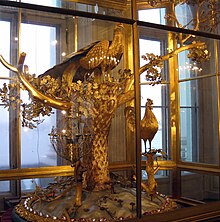Peacock (Fabergé egg)
| Peacock Fabergé egg | |
|---|---|
| Year delivered | 1908 |
| Customer | Tsar Nicholas II, as a gift for Dowager Empress Maria Feodorovna |
| Current owner | |
| Individual or institution | Edouard and Maurice Sandoz Foundation, Switzerland |
| Year of acquisition | 1955 |
| Design and materials | |
| Workmaster | Dorofeiev |
| Materials used | Gold, silver, diamonds, rubies, rock crystal |
| Height | 19 cm |
| Surprise | Mechanical gold and enameled peacock |
The Peacock egg is a jewelled and rock crystal Easter egg made by Dorofeiev under the supervision of the Russian jeweller Peter Carl Fabergé in 1908,[1] for Nicholas II of Russia, who presented the egg to his mother, the Dowager Empress Maria Feodorovna in 1908.[1]
Surprise
The surprise is a mechanical gold and enameled peacock, sitting in the branches of an engraved gold tree with flowers made of enamel and precious stones. The peacock can be lifted from within the tree and wound up. Placed on a flat surface, it struts around, moving its head and spreads and closes his enamel tail.[1]
Dorofeiev, the Fabergé workmaster, reportedly worked on the peacock and its prototypes for three years.[1]
History

The 'Peacock egg' was inspired by the 18th century Peacock clock by James Cox. It was housed first in the Winter Palace, and now in the Hermitage Museum in St. Petersburg, Russia. The Peacock clock was a present from Grigori Alexandrovich Potemkin to Catherine the Great.[2]
In 1927 the Peacock egg was sold with nine other Imperial eggs by the Antikvariat to Emanuel Snowman of Wartski in London. Bought by a Mr. Hirst in 1935, it was sold to Dr. Maurice Sandoz of Switzerland in 1949, and donated to his Foundation Edouard et Maurice Sandoz, Lausanne, Switzerland in 1955. Since its purchase by Sandoz, it has only been seen publicly six times, the last time in 2009.[2]
